Despite the fact that the basics of the genetics of dog colors are quite simple and have been considered in detail by many authors when you go beyond these basics, then everything becomes much more complicated.
Studying dog colors is also complicated by the fact that many authors use the same terms to refer to different genetic results. Many breeds use general terms to refer to colors and their shades, which in fact appear in different ways. Under “sable” color in different breeds means a different color, as well as under “brown”.
There are many nuances that should be considered when talking about the genetics of the colors of a particular breed. The genes and alleles that are responsible for coat color and shade are not yet fully understood and there is sometimes debate about this.
Understanding Color Genetics
Colors are controlled by a series of alleles of several genes, each of which affects a specific manifestation of a trait and, in addition, can interact with each other. Genes are located in a specific part of the chromosome – the locus. Several genes located at the same locus of homologous chromosomes are called a series of multiple alleles.
In homologous chromosomes, a pair of genes located at the same locus is called an allele. Allelic genes are designated by the same letters (AA; aa; Aa, etc.)
Both allelic genes are necessarily responsible for the manifestation of a trait. The cells of each organism can simultaneously have only two allelic genes, one in each of the homologous chromosomes.
If both genes are the same, the individual is homozygous for this gene (cc; AA, etc.); if the genes are different, the individual is heterozygous (Bb; Cc, etc.). Allelic genes are in a certain relationship
If the presence of one gene suppresses the manifestation of the other, they speak of complete dominance. A gene that suppresses the action of another is called dominant and is indicated by a (capital) letter. The suppressed gene is called recessive and is indicated by a lowercase (small) letter. In other words, if both genes (dominant and recessive) are present in the dog’s genotype, then only the dominant gene will outwardly manifest itself.
There are 12 main loci, which in their combination determine the color and shades of the dog’s color. At each locus, there are 2 to 6 gene variants. Not all of these varieties are present in every breed. Consider the colors and shades of the German shepherd.
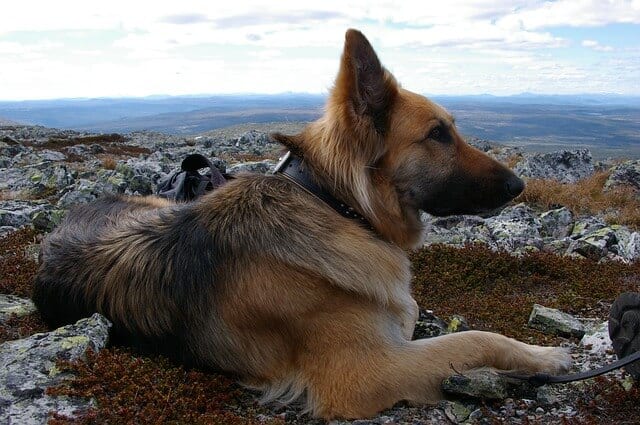
1) Locus A
A number of the most common German Shepherd color phenotypes are defined by a series of alleles known as agouti. “Agouti” (named after the North American rodent), the distribution of zones of eumelanin and pheomelanin along the length of the hair.
This locus contains 6 variants of the gene (alleles), and in most cases, it is this locus that interests us when we talk about the color of the German Shepherd. Let’s list the alleles in order of dominance from most dominant to most recessive (this means that the allele above in the list will appear in the dog’s phenotype, even if the second allele is lower in the list).
The actual presence of both alleles of a gene (the same (homozygosity for a given trait) or different (heterozygosity)) constitutes the dog’s genotype.
AND– dominant black color (solid black coat color (black terrier, Newfoundland)), does not exist in German shepherds.
ay – dominant yellow color, black nose, dark eyes, darker color along the back (sable color) (collies, Afghan hounds, Basenji). A very rare version of the zoned color in German Shepherds.
aw – zoned gray color (wild type) (shepherds, huskies) – a color that we usually call zoned (gray) in German shepherds. Both saber-haired and sable-gray dogs are genetically identical at this locus. Zone white dogs (very light tan) carry the lightening gene (Int).
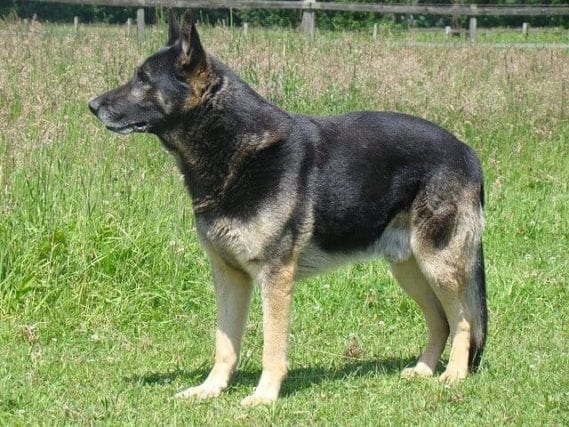
аs – black-backed color, saddle -cloth can be black or brown (shepherd dogs, airedale terriers). Black-backed is the most common color in German Shepherd Dogs (with tan variations from almost white to bright red, controlled by a series of intensity genes). At the same time, it is likely that another locus controls the amount of black in the dog’s coat, which has not yet been scientifically documented.
at– black and tan (two-tone) color – the presence of tan marks, the location of the pheomelanin zones is typical for the chest, abdomen, tips of the paws, above the eyes, and under the muzzle (Rottweiler, Doberman, Gordon setter).
Some authors and breeders believe that black and tan German Shepherds are black and brown dogs (as) with a different gene that is responsible for the area of black in the dog’s color, others believe that it is a separate gene from the agouti series. Based on the practice of studying the colors of other dog breeds, the second option seems more likely.
At first glance, the phenotypes (as) and (at) are similar, but black-backed individuals have more rufous than black and tan, especially on the face, shoulders, flanks, and limbs. However, a large spread of black in black and back color may resemble black and tan. Of these two colors, black-backed is the most variable.
a – recessive black color. It seems likely that in the German Shepherd the black color is not encoded by gene A. Thus, the black form, which is recessive in relation to all other colors of the agouti locus. However, it is still unclear whether the recessive black gene belongs to the same locus or not.
All data indicate that this is the only form of black color that exists in German Shepherds.
In contrast to the overwhelming majority of dog breeds, in German shepherds, black is the most recessive trait
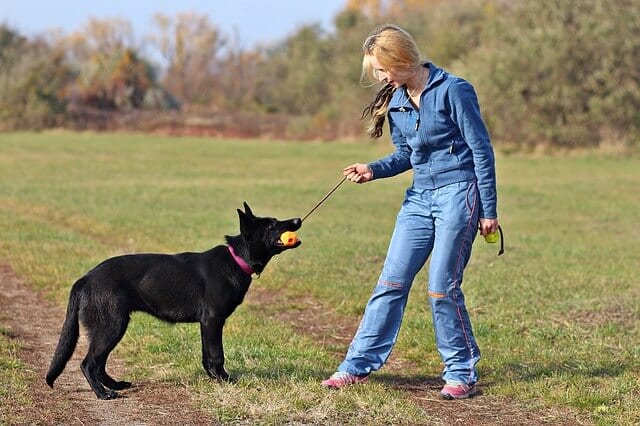
At each locus (in this case, locus A “agouti”) the dog carries two genes. It inherits one gene from Its father and one from Its mother. If the dog inherits an “a” (recessive black) from both parents, it will be black.
If Its inherits “a” from one of the parents and any other gene from the other parent, It will have the color that It inherits from the other parent (not black). In other words, if a dog carries genes “a” and “as”, it will be black-backed. If it carries genes “a” and “aw” – it will be gray (zoned). The dominance order is determined by the above list.
a + a = black
a + at = black & tan
a + as = black & tan
a + aw = zoned
at + a = black & tan
at + at = black & tan
at + as = black & back color
at + aw = zone color
as + a = black back color
as + at = black back color
as + as = black back color
as + aw = zone color
aw + a = zone color
aw + at = zone color
aw + as = zone color
aw + aw = zone color
Yellow color (ay) is not included in this table as it is extremely rare, if any, in German Shepherds. But you can easily include it in the table and see how it works.
Several practical conclusions can be drawn from this table:
- zone dogs can be of any other color in a recessive state and still be zone dogs
- a zone dog that has two “aw” genes (homozygous) can only pass on the “aw” gene to its offspring, and since this gene will dominate any other color gene that puppies may inherit from the other parent, all puppies of this dog will sounder
- a sounder dog can never be born
from two black-and-back parents (because if one of the parents had the “aw” gene, it would be phenotypically sounder) – only black puppies can be born from two black dogs.
Even dogs of the same color can have different shades. There are also other series of genes that affect both the general color of the dog and its shade and are inherited independently of the genes of the agouti series.
The primary color of the dog, which is controlled by the genes of the “agouti” locus, is also influenced by the allelic genes of this locus. Zoners with the aw + a genotype (which carry the recessive black gene) will be darker than aw + as dogs.
Also, the color of the undercoat affects the general color of the dog. Unfortunately, no documented information on the genetics of undercoat colors could be found. There is a very light undercoat (almost white), as well as a darker, red, gray, or black.
It should be noted that the white color is not part of this locus A, but is determined by a completely different locus.
2) Locus B
a structural gene of the protein matrix of melanosomes. This gene controls the black color of the coat and skin, nose, paw pads, etc.
B – ordered matrix structure, oval pigment granules. The dog has a black nose, black paw pads, dark lips, eyeliner, and claws. The standard gene for German Shepherds.
b– the protein matrix is a messy tangled ball, spherical pigment granules – brown (chocolate) color, brown nose and paw pads (Dobermans). The dog has no black pigment in its coat and skin. Such dogs are commonly referred to as “brown” or “liver”.
The most striking illustration of the colors that are controlled by the B gene are black and tan (at B-) and brown and tan (at bb) Dobermans. Refuting previous beliefs, it has now been established that this gene is not linked to other genetic defects. Extremely rare in German Shepherds.

Since this color is controlled by the genome of a completely different locus, it should be understood that you can have a brown dog that is genotypically black, black and tan, black & tan, or zoned. Such brown dogs will look slightly different as the “b” gene affects black pigment and black pigment is distributed differently in each of these colors.
The “b” gene blocks all black pigment, the dog phenotypically has a brown nose and brown coat where it should have been black. The influence of the “b” gene on the yellow pigment is insignificant. The “liver” color can be of various shades from light brown to chocolate. “Hepatic” dogs have light eyes.
3) Locus C
An albinism locus that controls the intensity of hair, eyes, skin coloration, the structural tyrosinase gene. This is the main series of genes that determines the white color in all dog breeds, including the German Shepherd (now the American Canadian White Shepherd, which is a separate breed but was bred from the white German Shepherds by fixing it in the offspring). The albinism locus is more mutable than other loci.
C – is responsible for coloration, regardless of color. Almost all German Shepherds of any color (except white) have this gene.
cd – standard white color, eyes, nose, paw pads are dark (poodle, lapdog, spitz). A typical gene for the American Canadian White Shepherd.
cch– weakening of the action of the yellow pigment, up to its absence (chinchilla color in rodents, when the yellow color in a separate wool, or in an entire area, turns into white). Chinchilla color has not been confirmed in German Shepherds, but may be the cause of white in some American Canadian White Shepherds when the cch + cch gene is present with the ay + ay gene. This combination is undoubtedly present in other white-colored breeds.
cb – weakening of color to light gray with simultaneous weakening of eye color to blue (poodle, Pekingese). Not found in German Shepherds.
c – complete albinism, melanin is not deposited on the matrix due to a tyrosinase defect
(more often in dogs, bulldogs). A dog with white hair, pink nose, paw pads, and red eyes. Complete albinism is extremely rare in dogs.
It follows that a white dog can carry any gene of the agouti series, which is manifested if this dog is mated with a dog carrying the gene of full color “C”.
White German Shepherds (American-Canadian) are not a cross between breeds but are bred from purebred German Shepherds. They are also not albinos. The white “cd” gene is recessive to the “C” gene (full color) and a white dog may arise from two normally colored parents who carry this gene latent.
It also follows from the recessive nature of inheritance that two white dogs can only produce white offspring. If a white dog is mated with a normally colored dog that does not carry the gene of white color, then all puppies born will be normally colored (white dogs in this combination will not be born).

4) Locus D
A gene for dilution. The influence of a given series of genes depends on which genes the dog carries at other loci.
D – determines the normal shape of melanocytes with processes, does not affect the main color.
d– causes an intermittent distribution of pigment granules in the hair, the main color of the coat is weakened and the pleiotropic effect in the form of lightening of the eyes (in the case of the presence of genes of black color, this allele leads to the appearance of a blue coat color (weakening of black color B to blue) – Great Dane; brown color becomes cream – poodle).
Thus, the “d” gene is responsible for the reduction of pigmentation. Despite previous beliefs, the lightening of the color is not linked to any other genetic defects other than a general loss of pigmentation intensity, however, in some breeds, there is a linkage of the genotype “dd” with some skin problems. Gene D is described as completely dominant to d.
Gene “b” acts only on black pigment, therefore, all red phenotypes look normal, but the presence of this gene is revealed by changes in the color of the iris of the eyes, skin, claws. The “d” gene weakens red to cream and black to blue and affects both eumelanin and pheomelanin.
As a result of the action of the “d” gene, to the human eye, the coat will appear gray in the case of black pigment or fawn in the case of yellow pigment. Differences in the disposition of pigment granules are due to a pair of genes: D and d. The latter causes an intermittent distribution of pigment granules in the hair.
Thus, gene D is responsible for intense staining, and gene d is responsible for weakening pigmentation. The “d” gene affects both black (brown) and yellow pigmentation. Hence, blue-tan and lilac-tan would be more correctly designated as blue-cream and lilac-cream. However, the prefix “tan” should be retained in cases where it is necessary to emphasize a certain pattern of color distribution.
At birth, B-dd blue German Shepherd puppies appear “gray” (asphalt colors) or “silver”, but not the usual black color. The recessive blue gene is a “dilution” gene that “dilutes” (lightens) all black pigment in a dog to blue and red to fawn.
These dogs have a gray nose and a gray “bloom” on the coat. The blue color can vary from a slight “blue” bloom on the coat to a dark “steel” color. Blue dogs also have very light eyes. Their color can change with age: they are often blue at puppyhood, but as they grow, their color changes, often ending in the form of a yellow or light brown bloom.
To exclude errors when registering puppies, you should examine the litter in a well-lit room in daylight. Blue puppies stand out from their normal counterparts with a bluish bloom on the coat and a non-black (albeit very dark) nose. It should be remembered that in a blue dog – the nose and rims of the eyes are evenly tinted with dark gray and light eyes. In a dog with winter depigmentation, the nose is not evenly colored – “streaks” are visible, the nose is lighter in the middle, and darker on the edge.
Any of the main colors can turn out to be weakened – the zonal changes not too abruptly, often a blue-zoned color is given by a grayish nose and paw pads, light eyes, black-backed, black-and-tan and black acquire a bluish coating with a gray nose, very light eyes, seeming blue in the first months of the puppy’s life, gray pads and the general Weimaraner color.
Contrasting colors become paler and more washed out. The most unusual of all “diluted” colors is pure blue, which is obtained by diluting pure black.
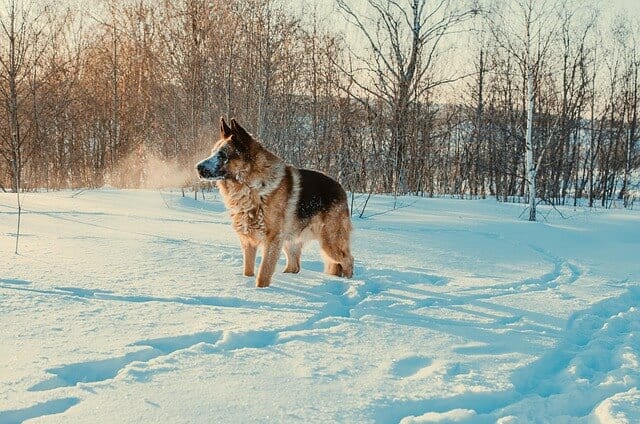
5) Locus E
responsible for the distribution of black and yellow pigment, which is similar to the work of the agouti locus. The mechanism of action is associated with an increase or decrease in the amount of eumelanin in the coat. It is possible that this series of alleles control the presence, absence, and extent of only black pigmentation on the trunk surface.
Ebr – black stripes on a yellow background (brindle) (French Bulldog, Greyhound). Not present in German Shepherds.
E – the wild-type allele determines the normal distribution of black pigment due to the action of other loci. The most common gene in German Shepherds.
e– recessive yellow color, complete disappearance of black pigment in the coat, but not on the nose and pads, phenotypically indistinguishable from the dominant yellow color, the genotype is established only using genetic analysis.
In the case of the action of the alleles of the A locus, the development of a yellow color against a predominantly black or brown background is observed, while the alleles of the E locus are responsible for the appearance of black areas on a yellow background.
The original wild-type E gene is responsible for the spread or production of black pigment over the entire body, for example, in pure black, black-backed, or black and tan dogs. When the E to e gene is mutated, the entire hair pigment becomes yellow, i.e. the synthesis of black pigment stops. In this case, it becomes impossible to identify the expression of agouti alleles, because their expression depends on the presence of black pigment.
Consequently, all of the above genotypes, when replacing E with e, will give only a red color of varying degrees of intensity. Locus E is characterized by complete domination, however, there are dogs with incomplete dominance of E over e, which leads to a decrease in the black pigment in the dog’s color and its replacement by red.
It is possible that the “e” gene is also found in German Shepherds and produces a weakening of black pigmentation in heterozygous (Her) or completely ginger dogs (her) retaining only a slight black mask, however, no studies have been conducted to prove this.
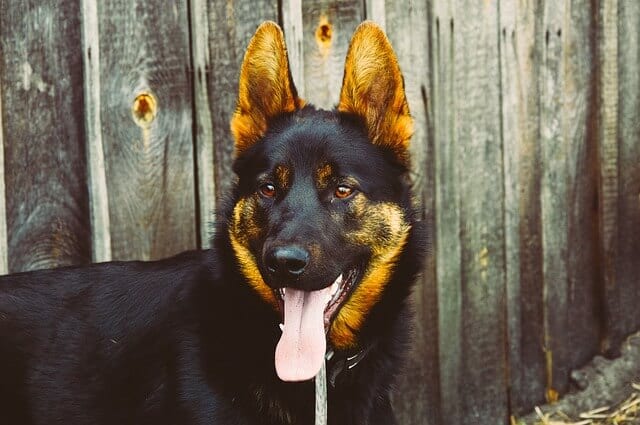
6) Locus G
progressive graying (lightening of color). The term “graying” is used in mammalian genetics when it is necessary to note the appearance of a significant amount of white hair on the body. In this case, the number of dark hairs exceeds the number of white ones and the animal appears dark, mottled with white hairs. If there are more white hairs than dark ones, then this color is called roan. It is not yet clear whether these are two separate genetic forms or different degrees of expression of one gene.
Graying is also classified as permanent and progressive. In the first case, it occurs at a certain stage of development and remains unchanged with age. Progressive graying occurs gradually over a significant period or throughout life. Graying of the second type is associated with the G.
G gene- puppies are born black (or intensely colored), then gray (brighten) to blue. Gg heterozygotes can change to dark blue-gray. In some cases this happens quite quickly, but, in general, animals turn gray throughout their lives.
Similar changes occur with homozygotes, but more dramatically and deeply. In combination with other alleles, Gg gives a slight lightening of the color, while GG – a sharp reduction in pigment. This gene does not exist in German Shepherds, but is the most common gene in, for example, Kerry Blue Terriers.
g – no graying. Puppies are born black and remain black. All German Shepherds carry the “gg” genotype.
7) Locus M
The color of a thrush (merle), irregular spotting of two tones of the same color (black and gray-blue or red-brown and light red) (collie, dachshund, Norwegian hound).
M is a dominant mutation that has no effect on eumelanin; in the homozygous state (MM), it causes a lethal effect at the embryonic stage or immediately after the birth of puppies. In the case of the birth of homozygous individuals (MM), they have a solid white color, partially or completely blue iris of the eye, often a reduced eyeball, partial or complete sterility, often blind and deaf.
The merle color is found in collies, shelties, dachshunds, dogs and is obtained in the case of a heterozygous state of the M gene, which is dominant in relation to the original m.
m– solid color, the color of which depends on the alleles of other genes. All German Shepherds have the genotype “mm”.
8) Locus S
Piebald, determining the nature of the distribution of painted and unpainted areas, which is expressed in the spotting of the cover. The pattern is associated with the centers of pigmentation – the area of the withers on the back, the root of the tail, ears, alternatively the centers of depigmentation – the chest, abdomen, tips of the paws, tail.
In animals with a characteristic white spot, there is great variability in the manifestation of this trait. The appearance of spots is a consequence of the disappearance of pigment in certain areas of the coat.
S – the wild-type allele defines a solid color. Most German Shepherds carry this gene.
si– Irish spotting, responsible for the centers of depigmentation, dogs have small white spots on the chest, abdomen, paws and a large surface of the stained. No studies have been conducted to determine the presence of this gene in the genotype of German shepherds. It is possible that some shepherd dogs carry the si gene, which manifests itself in the phenotype as white spots on the chest, legs, and tip of the tail. The S locus is also susceptible to modifier genes that can cause white spots even in the SS genotype (solid color).
sp – typical piebald (beagle, basset, hounds).
sw – controls the centers of pigmentation, coloration appears in the form of separate spots on the ears, spine, at the root of the tail.
Extreme recessive manifestation results in uncolored, but colored eyes and nasal mirror.
It is very important for practical cynology that in addition to these genes, a large number of modifier genes also affect the development of white spots. Therefore, there are so many options for white spotting.
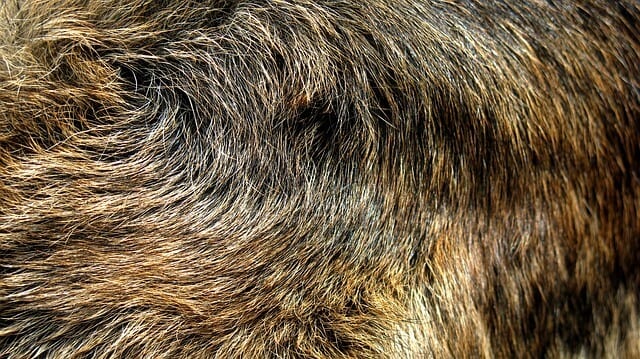
9) Locus
T– teak, white areas covered with numerous small pigmented spots. The teak spot is absent at birth and appears from a few weeks of age to the puppy’s first molt. Expression of the T gene is very variable: from a few small specks to such an abundance that the white areas of the body appear roan.
In long-haired breeds, teak looks like a roan due to the fact that long hair of different colors mixes easily. In some breeds, there is a tendency towards an effort of teak on the legs and abdomen.
T – teakness.
t – no tickiness. All German Shepherds carry this genotype (tt).
10) Locus R
Roan, determined by uniform mixing of dyed and undyed hair in the coat.
R– dominant roan color with a recessive lethal effect, sometimes dogs with this color have reduced vitality (airedale, poodle).
r – wild-type allele, uniformly colored coat. Most likely, all German Shepherds carry the genotype “rr”.
rt – teak color, dark spots on a white background (Dalmatian, English Setter, sometimes Pointing Dogs, Spaniel).
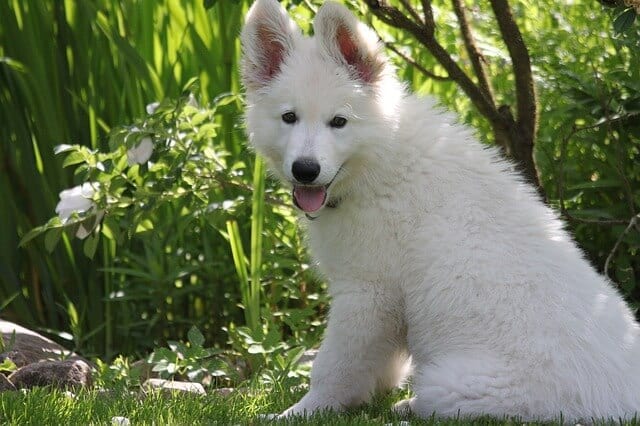
11) Locus W
Dominant white color, melanocytes do not enter the skin, but the iris and nasal mirror are colored (Kuvasz, Komondor, Maltese lapdog, South Russian Shepherd Dog).
w is the color of the wool.
For this locus, there are ambiguous opinions in the literature and it is not fully understood.
All German Shepherds are believed to carry the “ww” genotype. As for the American-Canadian white shepherd dogs, there is no consensus on this matter, although most authors are inclined to believe that the majority of the American-Canadian shepherd dogs have the genotype “cd-“.
12) Locus Int
A series of color intensity alleles. The action of these genes is mainly aimed at increasing pigmentation.
Int – light tan, produces the most pale tones.
intm – Average tan intensity.
int is the brightest tan.
Color Variations of German Shepherds
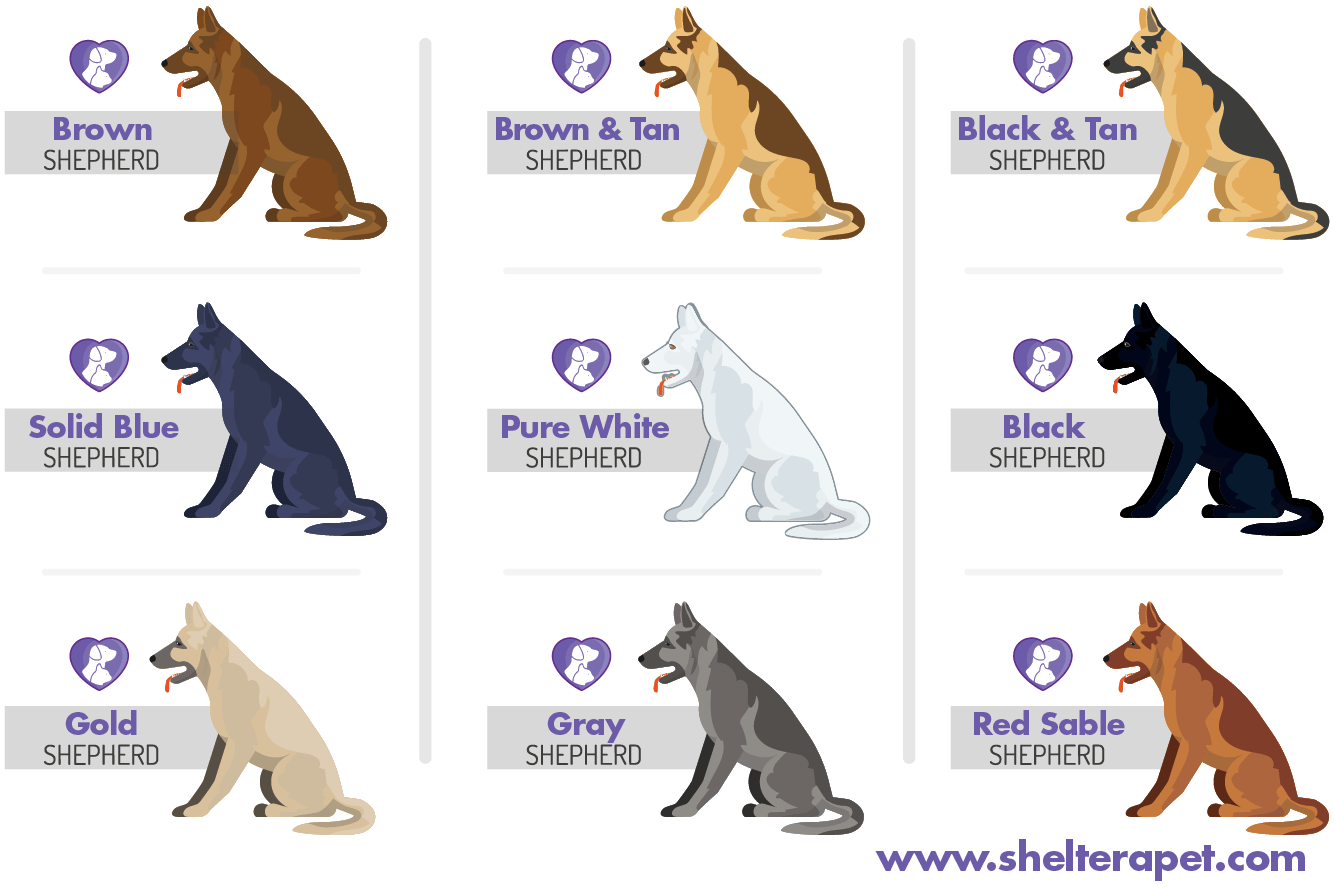
The most common color in the breed is black-backed… Ideally, black-backed dogs are those with a V-shaped dark spot on the back and sides of the torso, extending from the back to the belly.
However, both the distribution and the intensity of pigmentation in this area can vary. With bright, intense pigmentation, the black-and-back color is easy to identify, but with lighter pigmentation, the borders of the saddle cloth are blurred and its presence is difficult to recognize.
Strictly speaking, the blackness variability is determined by two independent systems of modifiers. On the one hand, these are modifiers that control the variability of the saddle cloth, its intensity, shape, and length. On the other hand, tan color is determined by Rufus polygenes, as is the case with pure red dogs. Moreover, they do not affect the expression of the blackness gene.
So, black-and-back color can be represented by genotypes:
asas BB CC DD EE gg mm SS tt rr ww intint Black-backed
color with the usual amount of black in the color and with a bright tan.
as – black-backed color;
B – black pigment is present;
C – complete pigmentation;
D – color is not weakened;
E – black pigment is distributed throughout the body;
g – there is no age-related weakening of color;
m – no Merle factor;
S – there is no white spot;
t – no speck;
r – no pride;
w – no dominant white color
int – bright tan.
The black-backed color can go down to the very elbows of the dog. It should be distinguished from black and tan (bi-color). Black and tan dogs have much more black in color, red markings remain on the paws and sometimes on the muzzle.
as (at or a) BB CC DD EE gg mm SS tt rr ww intm (intm or int) Black-backed
color with a lot of black and medium tan.
as – BB CC DD EE (or Ee) gg mm SS tt rr ww intint
A black-backed dog with a lightened saddlecloth and a mask.
Zone gray color:
awas BB CC DD EE gg mm SS tt rr ww intm (intm or int)
Zonal red with medium tan intensity.
aw (at or a) BB CC DD EE gg mm SS tt rr ww intm (intm or int)
Dark zoned color with a lot of black in the color and with a medium tan intensity.
awas BB CC DD EЕ (or Ee) gg mm SS tt rr ww intm (intm or int)
Clarified reddish color with a mask.
Black and tan color:
at (at or a) BB CC DD EE gg mm SS tt rr ww intint
Black and tan with lots of black and bright tan.
Black color:
aa BB CC DD EE gg mm SS tt rr ww Int (no expression possible)
Black color.
Caution When Choosing A Rare Color
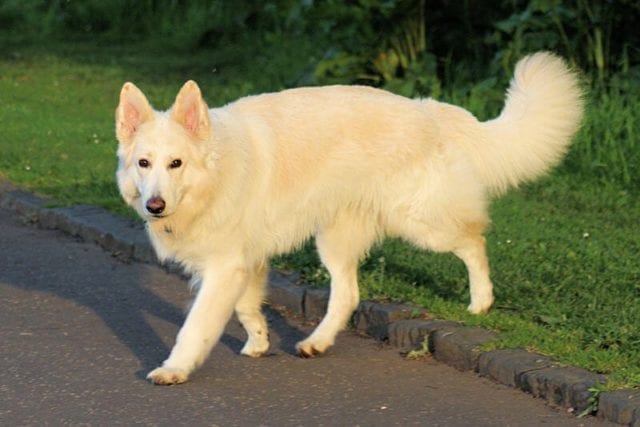
Above are the formulas for the standard colors of German Shepherds. If you come across a breeder who offers a dog of an “exclusive” rare color (blue, liver, cream, white, etc.), be very careful.
These colors are not “rare” or “exclusive”, they are not allowed by the German Shepherd breed standard! Although it has not been confirmed that “bleached” (“dilute”) colors are associated with any health problems in the dog, recessive genes are believed to be undesirable in the German Shepherd, as the accumulation of recessive genes leads to an overall decrease in the animal’s vitality and resistance to the external environment.
In many of the service breeds, the “bleached” colors have been removed from breeding, with the exception of the brown and tan Dobermans. I would like to draw your attention that among the large list of dog breeds, one can clearly distinguish breeds with tan and solid blue colors. For solid blue breeds, there are no color problems. In breeds with blue-tan and isabella-tan colors – Dobermans, Pinschers, dachshunds – these colors are ultimately prohibited.
Final Thoughts
If a puppy with the best constitution and character has any color and strong pigmentation allowed by the standard, then it should be preferred to other puppies, even if this color is not so pleasant as other winning colors.
However, a well-built, irregular colored puppy is not a good puppy. Do not forget that color is not the main criterion for selecting dogs and should always be subordinated to the type, constitution, movement, and character of the dog! And at the same time, color varieties mean a genetic variety. Genetic variety means health and strength.


